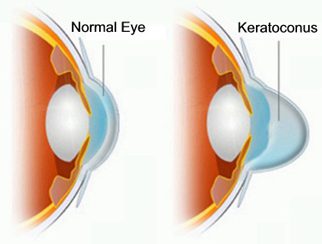The Cornea is part of the human eye and has an essential role in the quality of our vision. The transparent, dome-shaped layer covers the front of the eye and is very important for focusing light into the eye. But in some people, this vital structure can become weak and thin, leading to an eye condition called Keratoconus.
But in some people, this vital outer part of the eye can become weak and thin, leading to a condition called Keratoconus. Keratoconus is a progressive eye disease that causes the Cornea to bulge and changes shape into a cone. This makes it hard to see clearly and causes other problems with vision.
In this blog post, we’ll discuss what causes Keratoconus, how it can be diagnosed, and how it can be treated. We’ll also look at some interesting facts about this eye condition. What is Cornea:
What is Cornea
The Cornea is part of the human eye and constitutes the outer layer of the eye that covers the iris and pupil. The transparent, dome-shaped outer layer called the Cornea helps focus light and protects the eye. Corneal diseases have many kinds, such as infections, inflammations, dystrophies, and degenerations.
Cornea and Keratoconus
Several diseases affect Cornea. Among them, one is known as Keratoconus. This condition is where the Cornea gets thin and sticks out like a cone. This can make it hard to see. In this answer, I’ll talk about what causes Keratoconus, its symptoms, its diagnosis, and how it can be treated.
What causes Keratoconus
No one knows what causes Keratoconus, but it is thought to be a mix of genetics and the environment. Some studies have found that rubbing your eyes, having allergies, or having irritated eyes all the time may cause Keratoconus.
Keratoconus can cause several different symptoms, such as
- Blurry Vision that
- Increased Light Sensitivity
- Lights with halos or glare
- Night Vision problems
- Increases near-sightedness or squinting
- Strained eyes
- Eyes that are red or swell up
How to detect Keratoconus?
Detections of Keratoconus require a complete eye exam, preferably by a cornea specialist. The test they may prescribe include.
- The visual acuity test checks how well you can see from different distances.
- Refraction test: determines your prescription for glasses or contact lenses
- Corneal topography: makes a detailed map of your Cornea’s shape.
- Pachymetry. done to measure corneal thickness
- Slit-lamp exam. The eye doctor takes a look closely at the Cornea.

What is the treatment of Keratoconus?
Depending on the condition or severity of the disease, there are different ways to treat Keratoconus. Cases that aren’t too bad can be treated with glasses or contacts. Worse cases may need surgery. Some options for treatment are:
- Glasses or contact lenses: In mild cases of Keratoconus, corrective lenses can help improve vision.
- Corneal cross-linking is a procedure that uses UV light and a special solution to strengthen the Cornea and stop it from bulging more.
- Intacs are small, curved implants put in the Cornea to change its shape and make it easier to see.
- Corneal transplant: In severe cases, the damaged Cornea may need to be replaced with a healthy cornea from a donor.
Keratoconus: Disease & Treatment Summary: Keratoconus is a condition in which the Cornea thins and then tends to bulge into the shape of a cone, making it hard to see for the affected. If you think you might have Keratoconus, getting a complete eye exam is essential. If you have signs of Keratoconus, it is advised to see a corneal specialist. Based on the disease assessment and doctors’ decision, the treatment advisory may require a patient to use Spectacles, contact lenses, or a surgical procedure.

